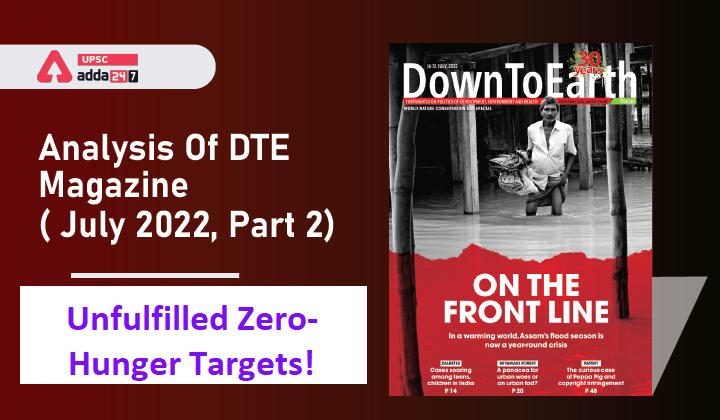Table of Contents
Down To Earth Magazine is a fortnightly magazine focusing on politics of environment and development, published in New Delhi, India.
UPSC Previous years’ questions on Development, Environment, Health and Disaster Management give us a clear idea about the increased importance of Down To Earth Magazine.
Down To Earth Magazine is one of the most important and indispensable source for UPSC Civil Services Exam Preparation. Keeping this in mind, here, we come with ”Gist Of Down To Earth Magazine” which covers important environmental current affairs articles in smooth pointed form, keeping in mind the demand of UPSC aspirants.
Unfulfilled Zero-Hunger Targets: Introduction
- Hunger has surged worldwide, and those who get to eat, are not eating healthy food. As a result, there is now a high prevalence of malnutrition, particularly undernourishment.
- Nearly every 10th person in the world does not have access to proper nourishment, as per the UN’s latest “State of Food Security and Nutrition in the World” report.
Unfulfilled Zero-Hunger Targets: What is Malnutrition?
- Malnutrition includes undernutrition, hidden hunger and overweight conditions. So, a country, where households are enduring both hunger and nutrition crises, is actually raising a generation of unhealthy citizens.
- Such high levels of malnourishment also means that people—particularly children— are not eating according to the need or nutritious value.
- Malnutrition is a foundational challenge: a malnourished child would grow up to be an unhealthy adult. A country with a high level of malnourishment, thus, will have an unhealthy population.
Unfulfilled Zero-Hunger Targets: How Covid-19 Pandemic and the Russian-Ukraine War impact Zero-hunger targets?
- The covid-19 pandemic and the Russia-Ukraine war have stalled the global progress on achieving zero-hunger and malnourishment targets under the UN’s Sustainable Development Goals (SDGs) for 2030.
- In 2021, nearly 30 per cent of the world’s population —2.3 billion—was food insecure.
- This was an increase of 350 million people over 2019. This lack of access to food or inability to afford food has a direct link with the level of malnutrition.
- The UN report says that the prevalence of undernourishment in the world has gone up from 8 per cent in 2019 to 9.8 per cent in 2021.
- In 2030, some 8 per cent of the global population will be malnourished—this was the level in 2015 when SDGs were set.
Unfulfilled Zero-Hunger Targets: What has changed since 2015?
- In 2015, the world agreed to eradicate hunger and malnutrition with adequate and healthy food.
- But the clock has now reversed, and the world is in the same crises as it was before 2015.
Unfulfilled Zero-Hunger Targets: How Malnutrition is a development challenge?
- While hunger can be tackled with food supply, the menace of malnutrition is difficult to fight with this approach.
- Malnutrition is also a development challenge that will haunt us in future because a country cannot base its growth on an unhealthy workforce.
- Rather, the disease burden of a malnourished generation will be too high for the country to fund and sustain. This makes the availability and affordability of healthy diet or good food an existential as well as an economic challenge



 TSPSC Group 1 Question Paper 2024, Downl...
TSPSC Group 1 Question Paper 2024, Downl...
 TSPSC Group 1 Answer key 2024 Out, Downl...
TSPSC Group 1 Answer key 2024 Out, Downl...
 UPSC Prelims 2024 Question Paper, Downlo...
UPSC Prelims 2024 Question Paper, Downlo...
